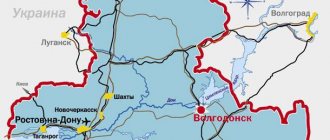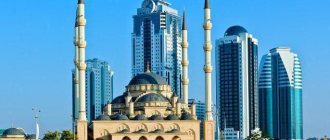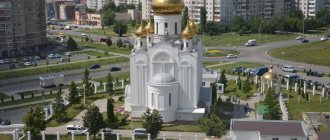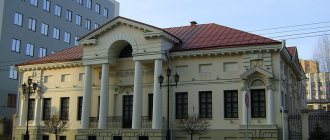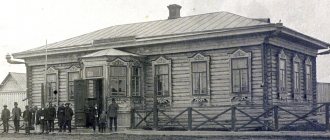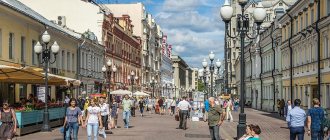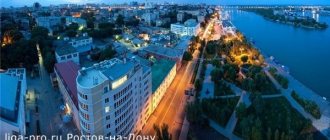From the editor: The history of the city of Dankov on the Don is still shrouded in secrets and replete with historical inaccuracies. The official founding date of Dankov has been set several times, and all of them are unfair.
The last date of formation, 1568, was imposed by the regional authorities; under its pressure, the year of formation of the city of Dankov was established (Before that, the dates were 1521 and 1523). I would like to hope that historical truth will prevail. Thanks to officials, Dankovites celebrated the 450th anniversary of the city twice, and this is from the realm of ignorance.
At least there is a document that mentions the year 1283. This letter contains a petition from the metropolitans of Kolomna and Ryazan to Tsar Ivan the Terrible, so that he would fairly judge the belonging of the Donkovo lands to the Kolomna, or Ryazan diocese. The Ryazan Metropolitan was able to provide documents dating back to 1283, but the Kolomna Metropolitan had no evidence. That is, in 1283 and earlier Dankov (Donkov) already existed and owned land plots. This is confirmed by the chairman of the Dankovsky Society of Local History, Ivan Fedorovich Malyukov. In the film “Donkovo Cossacks - Rising from the Ashes,” which can be viewed on this page below, there is an interview with Ivan Fedorovich.
It is worth mentioning the name of the city. The letter “a” appeared in the name in the 18th century, during the reign of Catherine the Second. Apparently the queen, a German by nationality, wrote Dankov, not Donkov, in one of the documents. It is clear that the officials did not dare to contradict the empress.
The word Donkov itself appeared thanks to the merger of two languages, Turkic and Old Russian. In Turkic “Don” is a river, and “kov” in Old Russian is a bend. That is, Donkov is nothing more than a place at the bend of the river. Indeed, the Don has a bend in the shape of a horseshoe, both at the current location of the city and at the Streshnevsky settlement.
Let us recall that the existence of Turkic tribes dates back to the 3rd-4th centuries BC. e. These times were marked by great events, for example, the beginning of the construction of the Chinese Wall and when our ancestors the Scythians captured Asian Sogdiana.
Based on archaeological finds on the territory of the Dankovsky district, we can safely say that the city of Dankov is the most ancient in the region.
The only question that arises is the location of the foundation. It is not yet clear where the Donkov fortress originally stood, on today’s site, or on the Streshnevsky settlement, 40 km higher along the Don. Since the fortress burned more than once and the city “moved.” But this situation cannot be taken into account either. After all, if a person’s house burned down and he built it in another place, this does not mean that someone, for their own reasons, should change his last name and year of birth.
The antiquity of Dankov is confirmed by archaeologist A. Levenok’s excavations of the Dolgovskaya Neolithic site near the village. Long, Scythian and Sarmatian burials, near the city of Dankov. These are also tribes of the 3rd-4th centuries BC. e. This means that this area has been inhabited and provided everything a person needs for life since ancient times.
Evidence of the importance of Dankov, which stood on the road to ancient Byzantium, is medieval maps. We give as an example a map of the late 16th century, where there is Donkov, but there is no vaunted and supposedly “ancient” Yelets. By the way, according to chronicle documents, Yelets was built by Donkovo Cossacks, that is, Cossacks. There is plenty of evidence that the Cossacks originated on the Dankov lands and nowhere else, watch the film below.
The map can be viewed in high resolution at this
.
Dankov, this is the story of a small town, the fate of which is similar to other county and later regional centers.
Official history of Dankov
According to official statements, the city of Dankov was founded in 1568 and was originally located on the left bank of the river. Don 30 km from the modern city. Built to protect the southern borders from attacks by the Crimean Tatars, it played an important role in organizing the Russian guard service.
Burned in 1618 by Hetman Peter Sagaidachny, Dankov was revived the next year, but in a new place. The city took its modern location on the right bank of the Don at the confluence of the river. Vyazovnya. The Dankov fortress with four roadways and two blind towers was located on a hill, at the beginning of the modern street. K. Marx. In the fortress there was a wooden cathedral church in the name of the Nativity of the Blessed Virgin Mary, a governor's courtyard, a hut, a well, and a cellar for storing weapons. Around the fortress there were Storozhevaya, Streletskaya, Cossack and Pushkarskaya settlements. On the right bank of the river. Vyazovny, at its very confluence with the Don, stood the Pokrovsky Monastery. Over time, the city lost its military significance; its fortifications became dilapidated and began to be dismantled. One of the fortress towers existed until the beginning of the 19th century.
Dankov
(Lipetsk region)
OKATO code:
42209501
Founded:
1568
Urban settlement since:
1941
City since:
1959 City of district subordination (Dankovsky district, Lipetsk region)
Center:
Dankovsky district
Telephone code (reference phone)
| 47465***** | 62-2-22 |
Deviation from Moscow time, hours:
0
Geographic latitude:
53°15′
Geographic longitude:
39°09′
Altitude above sea level, meters:
140 Sunrise and sunset times in the city of Dankov
Dankov history of development
According to the plan approved by the Emperor on August 31, 1780, the city of Dankov developed in a westerly direction. The administrative part, represented by wooden buildings of public places, a prison hut and a prison building, was previously located between two stone churches: the Nativity of the Virgin Mary Cathedral and the Church of St. Demetrius of Thessaloniki, according to the plan, is moved behind the Demetrius Church. Opposite the public places it was planned to build a magistrate and a guest courtyard. The city, divided into quarters, increased its area due to the partial annexation of settlements. The modern central part of Dankov, enclosed between the Don, Vyazovnya and st. Zastavnoy, corresponds to the plan of 1780.
Pre-regular plan of the city of Dankov, 1780s.
The process of rebuilding the city was lengthy. The stone two-story building of public places (K. Marx St., 7) and the prison castle were built only in 1835. The place designed in the plan for bread and wine stores was built up with a two-story building in 1842 (it is currently part of the Dankov hospital ).
In 1864, the city had 4 state-owned and 326 philistine houses (17 of them stone), 5 streets and three squares: Drovyanaya, Gostiny Dvor and Khlebnaya. In 1861-1878. On Khlebnaya Square, construction was underway on a new two-story stone cathedral in the name of the Tikhvin Icon of the Mother of God. Occupying a vast area in the city center, the cathedral is the dominant high-rise volume in the surrounding space and is perfectly visible from long distances outside the city. In the second half of the 19th - early 20th centuries. in Dankov, other stone churches are being built and rebuilt - in the name of St. Demetrius of Thessalonica, Nativity of the Blessed Virgin Mary, St. George the Victorious, St. John the Evangelist and the Nativity of Christ, which also became the main high-rise and architectural dominants of the city.
The city of Dankov in the mid-19th century. Market Square (now V. I. Lenin Square)
Economically, Dankov was not rich. From the description of the city in the mid-19th century, compiled by the city mayor, merchant V.I. Ermakov, it follows that “all 71 merchant families hardly have cash capital and goods, with the exception of houses, more than 400 thousand rubles, and therefore the wholesale trade of merchants cannot be placed on a par with the cities surrounding Dankov.” The city's commercial and industrial enterprises included 3 slaughterhouses, in which up to 15 thousand sheep were slaughtered per year, 9 grain crushers and butter churns, and two candle factories, which produced up to 800 pounds of tallow candles. Wholesale trade in Dankov was carried out only in bread. All other types of trade were defined as “insignificant”1.
With the construction of the railway and elevator in Dankov in the 1890s. the importance of the grain trade increased. At the end of the 19th - beginning of the 20th centuries. stone two-story houses of wealthy merchants P.D. appear in the city. Goleva, A.M. Shumilova, A.P. Lebedeva, V.G. Popova. They are still an architectural decoration of the city.
Also of historical and cultural significance are buildings that previously belonged to educational institutions: a state-owned men's gymnasium (now a children's art house and a planetarium), a private women's gymnasium and a higher city primary school (in Soviet times - a medical school), a religious school, which was located until 1870. in the Pokrovsky Monastery, and then in a specially built building (now secondary school No. 1).
Map
| Dankov: maps |
Dankov: photo from space (Google Maps) Dankov: photo from space (Microsoft Virtual Earth)
| Dankov. Nearest cities. Distances in km. on the map (in brackets along roads) + direction. Using the hyperlink in the distance , you can get the route (information courtesy of the AutoTransInfo website) | |||
| 1 | Lev Tolstoy | 20 (28) | IN |
| 2 | Lebedyan | 25 (34) | IN |
| 3 | Kurkino (Tula region) | 38 (52) | NW |
| 4 | Miloslavskoe (Ryazan region) | 41 (52) | NE |
| 5 | Red | 48 (151) | SW |
| 6 | Krivopolyanye | 52 () | IN |
| 7 | Chaplygin | 54 (60) | IN |
| 8 | Kind | 61 () | SE |
| 9 | Skopin | 68 (87) | NE |
| 10 | Efremov | 69 (70) | Z |
| 11 | Alexander Nevsky (Ryazan region) | 74 (117) | IN |
| 12 | Pervomaisky (Tambov region) | 75 (93) | IN |
| 13 | Stanovoe | 77 (116) | SW |
| 14 | Lipetsk | 77 (86) | YU |
| 15 | Ryazhsk | 79 (115) | NE |
| 16 | Tovarkovsky (Tula region) | 79 (98) | NW |
| 17 | Dace | 82 (113) | SW |
| 18 | Volovo (Tula region) | 82 (146) | NW |
| 19 | Bogoroditsk | 88 (110) | NW |
| 20 | Borinskoe | 89 () | YU |
| 21 | Kimovsk | 89 (118) | NW |
| 22 | Korablino | 93 (119) | NE |
| 23 | Novomichurinsk | 95 (127) | NE |
| 24 | Arkhangelskoye (Tula region) | 96 () | Z |
| 25 | Donskoy | 96 (133) | NW |
| 26 | Michurinsk | 97 (148) | SE |
| 27 | Zadonsk | 97 (162) | YU |
| 28 | Mud | 98 (115) | SE |
| 29 | Pronsk (Ryazan region) | 100 (120) | WITH |
| 30 | Izmalkovo | 100 (156) | SW |
| 31 | Petrovskoye (Tambov region) | 100 (190) | SE |
a brief description of
Dankov is located within the Central Russian Upland, along the banks of the river. Don, at the confluence of the river. Vyazovka, 86 km northwest of Lipetsk. Railway station. Road junction.
Territory (sq. km): 24
Information about the city of Dankov on the Russian Wikipedia site
Historical sketch
Dankov existed at the end of the 14th century, on the left bank of the Don, 34 km from the present city (near the modern village of Streshnevo). Here merchants traveling to Azov and Kafa (Feodosia) loaded their goods onto ships.
Founded in 1568 as a fortification on the site of the ancient Ryazan city of Donkov, destroyed by the Tatars. In 1618 it was moved to the other side of the Don at the mouth of the river. Vyazovni (Vyazovki). In the 18th century The Dankov form comes into use.
[Clarify the history of occurrence - sources give conflicting information].
Based on the position of the city on the river. Don and given the primary form of Donkov, the hydronym Don is usually seen as its basis. However, the formation of oikonyms on -kov from river names (Don > Donko > Donkov) has no analogues in Russian toponymy. The assumption about the existence of a tributary Donok (“little Don”) in the upper reaches of the Don, from which Donkov could have formed, is not confirmed by sources. Perhaps the basis is the personal name Danko (diminutive of Daniil), from which the name is derived using the suffix -ov.
Until the middle of the 17th century. a guard post to protect the Russian state from attacks by the Crimean and Nogai Tatars.
In 1708 it was assigned to the Azov province (from 1725 - Voronezh province), from 1719 to the Yelets province. Since 1778, the district city of the Ryazan governorship (since 1796 - Ryazan province). In 1796-1804 and 1925-41. village, Dankov - did not have city status.
In 1856, in the district town of Dankov, Ryazan province, there were 2 churches, 308 houses, 5 shops.
Since 1941, the working village of Dankov. Since 1959 it has become a city again.
Municipal indicators
| Index | 2001 |
| Demography | |
| Number of births, per 1000 population | 8.3 |
| Number of deaths, per 1000 population | 18.4 |
| Natural increase (decrease), per 1000 population | -10.1 |
| Standard of living of the population and social sphere | |
| Average monthly nominal accrued wages, rub. | 2147 |
| Average housing area per inhabitant (at the end of the year), sq.m. | 22.4 |
| Number of preschool institutions, pcs. | 8 |
| Number of children in preschool institutions, thousand people | 1 |
| Number of daytime educational institutions (at the beginning of the school year), pcs. | 7 |
| Number of students in daytime educational institutions, thousand people | 3.5 |
| Number of doctors, people. | 68 |
| Number of nursing staff, people. | 339 |
| Number of hospital institutions, pcs. | 2 |
| Number of hospital beds, thousand units | 0.5 |
| Number of medical outpatient clinics, pcs. | 2 |
| Capacity of medical outpatient clinics, visits per shift, thousand units. | 0.6 |
| Number of registered crimes, pcs. | 255 |
| Persons who committed crimes were identified, persons. | 239 |
| Economy, industry | |
| Number of enterprises and organizations (at the end of the year), pcs. | 253 |
| Construction | |
| Volume of work performed by type of activity “Construction” (until 2004 - volume of work performed under construction contracts), million rubles. | 33.7 |
| Commissioning of residential buildings, thousand sq.m. of total area | 7.1 |
| Commissioning of residential buildings, apartments | 91 |
| Commissioning of preschool institutions, places | 0 |
| Commissioning of educational institutions, places | 0 |
| Commissioning of hospital facilities, beds | 0 |
| Commissioning of outpatient clinics, visits per shift | 0 |
| Transport | |
| Number of bus routes (in intracity traffic), pcs. | 5 |
| Number of passengers transported by buses per year (in intracity traffic), million people. | 2.9 |
| Connection | |
| Number of residential telephone sets of the city public telephone network, thousand units. | 4.4 |
| Trade and services to the population | |
| Retail trade turnover (in actual prices), million rubles. | 205.6 |
| Retail trade turnover (in actual prices), per capita, rub. | 8675 |
| Public catering turnover (in actual prices), million rubles. | 13.3 |
| Volume of paid services to the population (in actual prices), million rubles. | 64.5 |
| Volume of paid services to the population (in actual prices), per capita, rub. | 2744 |
| Volume of household services to the population (in actual prices), million rubles. | 3.5 |
| Volume of household services to the population (in actual prices), per capita, rub. | 148 |
| Investments | |
| Investments in fixed assets (in actual prices), million rubles. | 83.7 |
| Share of investments in fixed assets financed from budgetary funds in the total volume of investments, % | 40.2 |
Data sources:
- Regions of Russia. Main characteristics of the constituent entities of the Russian Federation: statistical collection. Goskomstat of Russia. - M:, 2003.
Economy
Factories: chemical (production of varnishes, resins, oils, adhesives, sealants, catalysts, etc.), reinforced concrete products. Dolomite plant.
Food industry enterprises: meat and poultry processing plants, starch factories, dairy factories, bakery. Sewing factory "Cosmos".
Potatoes, sugar beets, and grains are grown in the Dankovsky district. They raise cattle, sheep, pigs, and poultry.
Deposits of dolomite, sand, clay.
Main enterprises
CHEMICAL INDUSTRY
JSC "Silan"
399820, Lipetsk region, Dankovsky district, Dankov, st.
Zaitseva, 14 Offers:
Synthetic resins and plastics
Culture, science, education
Local history museum and art gallery.
Museums, galleries, exhibition halls
Dankovsky Museum of Local Lore 399820, Lipetsk region, Dankovsky district, Dankov, st. Karla Marksa, 3 Phone(s): (47465) 6-6126
Architecture, sights
The old part of Dankov is located on the right bank of the Don and has largely preserved the appearance of a district Russian town of the late 19th century. Church of Dmitry of Thessalonica (1760s, early classicism; now a local history museum).
10 km from Dankov, in the village of Balovnevo, Vladimir Church (1799, designed by architect V.I. Bazhenov).
45 km from Dankov, in the village of Polibino, is the ensemble of the former estate of the Nechaev-Maltsevs (late 18th century).
| Population by year (thousands of inhabitants) | |||||||
| 1856 | 3.3 | 1989 | 24.7 | 2006 | 22.4 | 2015 | 19.6 |
| 1897 | 9.1 | 1992 | 24.7 | 2007 | 22.3 | 2016 | 19.3 |
| 1913 | 10.4 | 1996 | 24.8 | 2008 | 22.3 | 2017 | 19.1 |
| 1939 | 2.9 | 1998 | 24.6 | 2010 | 22.0 | 2018 | 19.0 |
| 1959 | 12.7 | 2000 | 24.1 | 2011 | 21.1 | 2019 | 18.8 |
| 1967 | 18 | 2001 | 23.7 | 2012 | 20.7 | 2020 | 18.7 |
| 1970 | 20.0 | 2003 | 23.2 | 2013 | 20.2 | 2021 | 18.6 |
| 1979 | 23.2 | 2005 | 22.6 | 2014 | 19.9 | ||
reference Information
Documents • Laws • Notices • Document approvals • Contracts • Requests for proposals • Technical specifications • Development plans • Document management • Analytics • Events • Competitions • Results • City administrations • Orders • Contracts • Work execution • Protocols for consideration of applications • Auctions • Projects • Protocols • Budgetary organizations Municipalities • Districts • Education • Programs Reports
: • by references • Documentary base • Securities
Regulations
: • Financial documents
Resolutions
: • Categories by topic • Finance • cities of the Russian Federation • regions • by exact dates Regulations
Terms
: • Scientific terminology • Financial • Economic
Time
: • Dates • 2015 • 2016 Documents in the financial sector • in the investment sector • Financial documents - programs
Yelets is a small town
Yelets never aspired to become big. This settlement is specially created for tourists, so local authorities are trying to develop the infrastructure. The authorities are undertaking various programs that are designed to regulate tariff rates for:
- gas;
- water;
- electricity supply;
- housing maintenance;
- improvement of housing stock.
The results generally please the townspeople, who receive playgrounds and landscaped courtyards. Moreover, for this they do not have to overpay significantly, since there are still the same well-thought-out tariffs.
There are practically no traffic jams in the city. However, due to the one-way traffic that prevails here, you may encounter slight congestion. The city has a sufficient number of schools and kindergartens, but many of them are paid. Residents of Yelets are employed in trade enterprises. Nowadays, catering establishments often begin to open in the city. Therefore, there is enough work, but finding employment can be difficult.
Old Dankov near Streshnevo
So, the old city of Donkov existed. There is no doubt about this and there cannot be. The famous Soviet scientist archaeologist A.L. Mongait in his study “Ryazan Land” also testifies that “The Old Donkovskoe fortification is the remains of a city of the pre-Mongol era...” During excavations at the old Donkova fortification near the village. Streshnev Leningrad archaeological expedition with the assistance of Dankov local historians, under the leadership of archaeologist Vsevolod Protasyevich Levenko, discovered objects of the 12th-16th centuries in 1959, which confirms the conclusion of historians.
Old Donkov was a fortress city and at the same time was of great importance in terms of trade: it was the most important pier on the Don. Shipping began from here, ships were built right there, goods were loaded onto them to be sent to Kafa, Azov, Constantinople and other cities of the Black Sea region. Russian merchants brought honey, wax, cloth, spicy roots, wines, fruits, beads, silver and gold items, weapons and other goods abroad.
Old Donkov repeatedly had to repel the attacks of detachments of the Tatar hordes, which for 300 years interfered with the peaceful work of the villagers with their unexpected predatory raids; more than once it was subjected to fire and destruction. And after 1521, when the city was completely destroyed, it was no longer restored in its old place. They did not do this, obviously, because the borders of the Moscow state moved far to the south. By that time, the Don had become so shallow that navigation along it from the old Donkov had ceased, and further down the river they found a convenient place for the construction of a new city, which in its natural conditions was better than the previous one.
Monument to old Donkov
Monument to old Donkov near the village of Streshnevo, on the site of the old fortress
In 1993, a monument stone was erected at the old Donkov settlement with the inscription: “Here stood the border fortress of old Donkov until 1521.” Not far from the monument, a well with a canopy in the old Russian style was built.
All this was built at the expense of the Dankovsky Dolomite Plant, whose general director is Fedor Vasilievich Korlykhanov.
New Dankov was built as a fortified military outpost on the state border. It became a necessary link in the system of border fortifications, called the Belgorod abatis line. This fortified strip protected the southeastern and southern borders of the Moscow state from the raids of the Crimean and Nogai Tatars, who, since the 13th century, had been roaming in large hordes and small detachments across the vast steppes around the Don and its tributaries.
The defenders of the Donkov fortress took water from this well.
Dense forests then grew here, and the steppes were covered with grasses as tall as a man, in which it was easy for enemies to hide and make surprise attacks on Russian villages. They burned cities and villages and plundered property. Whoever resisted them, they killed. Thousands of people were taken captive and sold like cattle into eternal slavery. To prevent the Tatars from penetrating Russian possessions, fortified cities were built on the outskirts of the state. Such a fortress city was the new Dankov, to which Dmitry Lyubavsky dedicated his poem:
On a high steep slope at the confluence of rivers, the town was built by a Russian man.
He created towers and walls, planted archers, gave the town a name - Dankov.
Boldly rising above the steppes, the fortress guarded both Moscow and Rus'.
The fortress guarded the peace of the Motherland, proudly towering above the Don River.
The infidels - the Tatars - will be given a lesson; they will not allow fires to burn their home.
The cruel enemy will disappear. Rus' will bloom. Rus' will henceforth grow stronger and stronger.
From that time on, people began to settle in the area. I knew that now they wouldn’t let us offend them...
Happiness and adversity Turned into dreams The years of Ancient antiquity faded away.
Lipetsk is a densely populated city in the central Black Earth Region.
Over the past ten years, there has been a significant outflow of the population, but people themselves say that many return here after a long stay in Moscow, where they are looking for decent earnings. Most Lipetsk residents need to move to the capital, with its attractive prospects, to save money to buy a home. Meanwhile, there are many problems with housing and housing and communal services. The list is quite long, but it can be boiled down to a few main difficulties.
In some areas, the population density is so high that utility services simply cannot cope with the maintenance of homes. Lipetsk is located in a climatic zone characterized by a sharp onset of winter. A large number of cars and sudden precipitation often lead to transport collapse. An insufficient number of snow removal equipment cannot provide the desired benefit. Yard cleaning is often completely forgotten.
The wear and tear of the heating mains regularly used by residents forces repair and restoration work to be carried out twice a year. Moreover, sometimes services do not do their job at all, which causes the infrastructure to suffer even more. Throughout the Lipetsk region there are not enough kindergartens and schools. In 2022, local authorities took many actions to correct the problem. So far, this only works in relation to new microdistricts where the construction of corresponding municipal institutions is underway. Electronic child registration plays a useful role, allowing residents to determine the child's position in the queue. There is also compensation, which is 5,000 rubles. — such a payment awaits everyone whose children were unable to get into kindergarten and were forced to continue to wait (valid for children from 3 to 6 years old).
Gryazi - industrial town
Mechanical engineering has become a city-forming industry for the city of Gryazi. The settlement plays an important role, being a major railway junction connected with Moscow, Rostov, Orel and Volgograd.
The population is provided with work, but has problems with infrastructure. Housing and communal services require serious improvement measures. The city has kindergartens, private schools, and an art gymnasium. The general situation in Gryazi is typical for any regional city that has a relatively good level of improvement. Young people often leave Gryazi to go to millionaires to look for education and work.
Dankov - border fortress
Drawing of the old Donkov fortress
There are still disputes about the date of his birth, and there is more than one city, but there was also Old Donkov. In periodicals, in individual publications and in reference literature, various dates for the emergence of the new Dankov are indicated. Some call 1570 the year of his birth, others - 1571, and still others claim that the city of Dankov arose in 1563. Some argue that old Donkov existed in the pre-Mongol period. Let's try to restore the truth by examining old documents and chronicles. Dankovsky local historians, founders of the first local history society in the Lipetsk region (1958) and the Dankovsky People's Museum Vasily Lukich Lukin, Ivan Andreevich Prasalov and Vasily Pavlovich Sosedov studied in detail the history of the city in the state archives of Moscow, Leningrad, Ryazan and came to the conclusion: the new city Dankov had a predecessor - old Donkov (the name comes from the Don River), which was located 32 km from the present one up the Don, where the village is located. Streshnevo.
The rampart of the old Donkov fortress, in the area of the former village of Streshnevo, overlooking the Don River
Here is what I. Dobrolyubov writes in the “Historical and statistical description of churches and monasteries of the Ryazan Diocese”: “Streshnevo, also called the Old Dankov settlement and Old Donkov, was located to the right of the large Epifan road on the banks of the Don River, in its place was the ancient city of Donkov, the time of its foundation, although unknown, should be dated back to the time of the formation of the first Slavic colonies on the upper reaches of the Don.
Donkov is mentioned in chronicles under the name Dubka on the Don no earlier than 1147. The oak tree was burned by Mamai in 1378. Donkov was mentioned under his own name already in 1521, when it was destroyed during the invasion of Makhmet-Girey”: The old city is described both in the “Book of the Great Drawing” and by Herberstein, an Austrian scientist who was in Moscow as the Austrian ambassador in 1517 and 1526 .
Education and science
Science
: Tests • Scientific and technological progress • Pedagogy • Work programs • Faculties • Methodological recommendations • School • Vocational education • Student motivation
Subjects
: Biology • Geography • Geology • History • Literature • Literary genres • Literary characters • Mathematics • Medicine • Music • Law • Housing Law • Land Law • Criminal Law • Codes • Psychology (Logic) • Russian Language • Sociology • Physics • Philology • Philosophy • Chemistry • Jurisprudence
Business and finance
Business
: • Banks • Wealth and prosperity • Corruption • (Crime) • Marketing • Management • Investments • Securities: • Management • Open Joint Stock Companies • Projects • Documents • Securities - control • Securities - valuations • Bonds • Debts • Currency • Real estate • (Rent) • Professions • Work • Trade • Services • Finance • Insurance • Budget • Financial services • Loans • Companies • State enterprises • Economics • Macroeconomics • Microeconomics • Taxes • Audit Industry
:
• Metallurgy • Oil • Agriculture • Energy
Construction
• Architecture • Interior • Floors and ceilings • Construction process • Building materials • Thermal insulation • Exterior • Organization and production management
Photo blogs
Art
• Children's creativity • Paintings • Art • Congratulations • Film review • Musical world • Russian rock
World
• People of the world • The world around us • My homeland is the USSR • Nature Channel • Stones and minerals • Cooking, food • Construction and architecture • Under construction • Transport • Weapons • Military transport
beauty
• Fashion Pandia.ru • Girls and Girls
School
• Tests for the Unified State Exam • Solver books • Unified State Examination • 10th and 11th grades • Various textbooks • 4th grade • Russian language grades 5-9 • 5th grade • 6th grade • 7th grade • 8th grade
Wisdom
• Cliparts • Quotes
Author Directory (private accounts)
AutoAuto service • Auto parts • Products for auto • Auto repair centers • Auto accessories • auto parts for foreign cars • Body repair • Auto repair and maintenance • Car chassis repair • Auto chemicals • oils • technical centers • Gasoline engine repair • auto electrical repair • Automatic transmission repair • Tire fitting BusinessAutomation of business processes • Online stores • Construction • Telephone communications • Wholesale companies LeisureLeisure • Entertainment • Creativity • Catering • Restaurants • Bars • Cafes • Coffee shops • Night clubs • Literature TechnologiesAutomation of production processes • Internet • Internet providers • Communications • Information technologies • IT companies • WEB studios • Website promotion • Software sales • Switching equipment • IP telephony | InfrastructureCity • Authority • District administrations • Courts • Utilities • Teen clubs • Public organizations • City information sites The sciencePedagogy • Education • Schools • Training • Teachers GoodsTrading companies • Trade and service companies • Mobile phones • Accessories for mobile phones • Navigation equipment |
